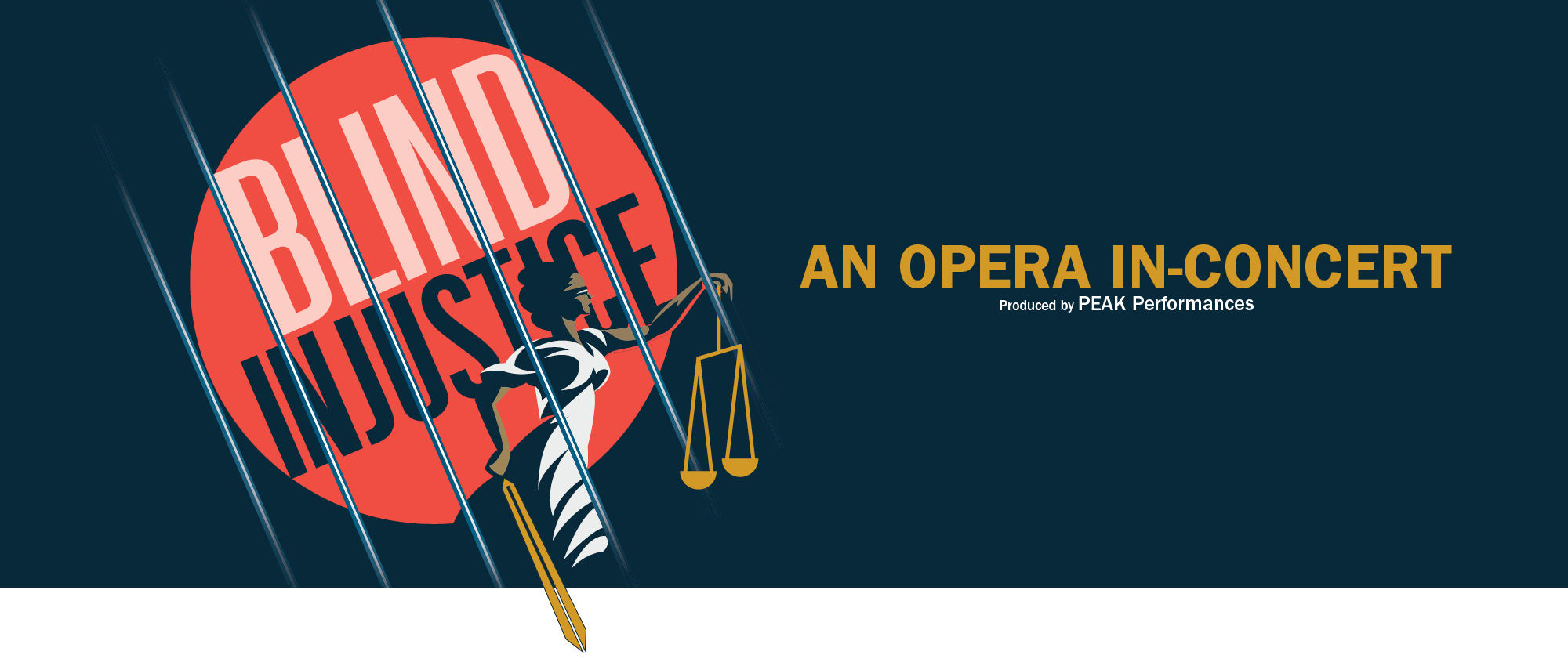The opera Blind Injustice draws on real research, real activism, and real people’s stories. Based on the book of the same name by Mark Godsey, the piece explores six cases of wrongful conviction in Ohio, all later freed through the work of the Ohio Innocence Project.
Below you can find more information about the real stories beyond the opera, how to learn more about the wrongful incarceration movement, and ways to get involved.
Navigate:
Section 1: The Stories
Listen to more music from the opera on Spotify.
“So I made a mistake…it happens.”
ALESHA
“And who do you think it happens to?”
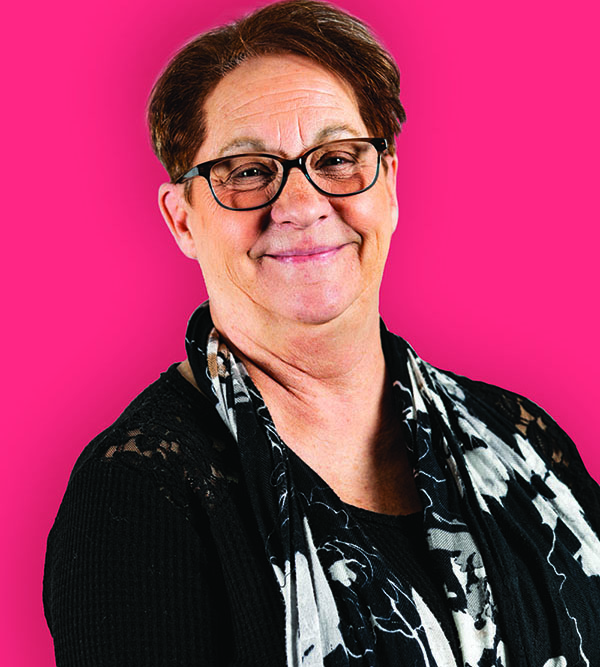
Nancy Smith
Imprisoned for 15 years
July 1994 to Feb. 4th, 2009
A school bus driver in Lorain, Ohio, Smith was wrongfully convicted of molesting children in her care, despite strong evidence of her innocence and inconsistencies in the testimony of the children. Her case was part of a moral panic in the ’80s and ’90s which led to the imprisonment of dozens of innocent childcare workers. She was released in 2009, and in 2022 had her conviction vacated.
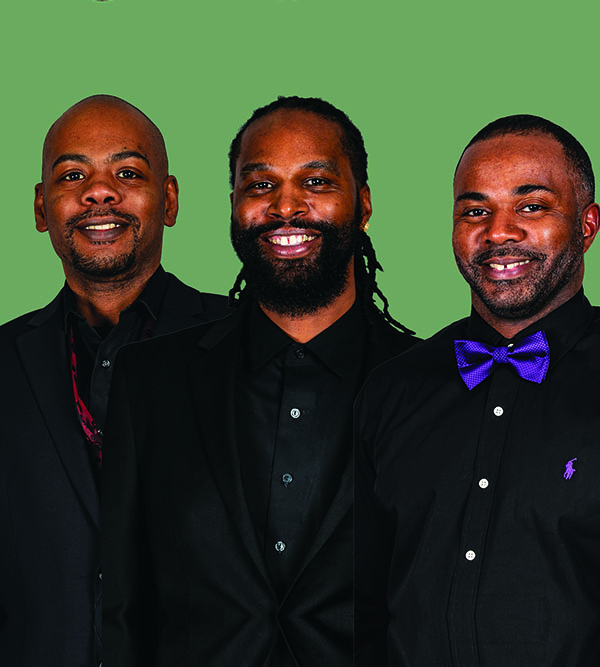
Derrick Wheatt, Eugene Johnson and Laurese Glover
Imprisoned for 19 years
January 1996 to March 26, 2015
Also called the East Cleveland 3, Johnson, Glover and Wheatt were accused of committing a murder based on the eyewitness testimony of a single teenage girl, who later stated that she was coerced by police. Between 2017 and 2018, all three received financial settlements for their wrongful convictions.

Clarence Elkins
Imprisoned for 6 years
June 1999 to Dec. 15th, 2005
After the tragic rape and murder of Judith Johnson and the rape of her granddaughter Brooke Sutton, police charged Clarence Elkins, Johnson’s son-in-law, with the crime. He was convicted based on Sutton’s statement that the perpetrator “looked like” her Uncle Clarence. DNA testing later proved that the attacker was a neighbor, leading to Elkins’s release.
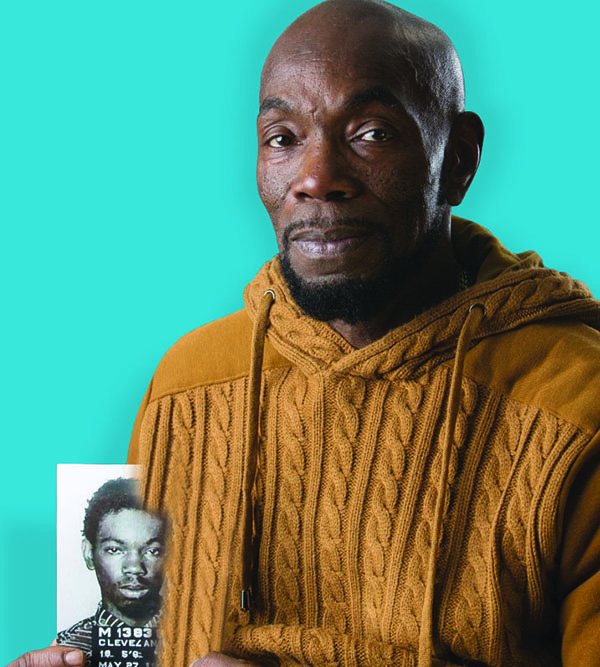
Rickey Jackson
Imprisoned for 39 years
September 1975 to Nov. 21, 2014
On the testimony of a single 12-year-old boy, Jackson and brothers Wiley Bridgeman and Kwame Ajamu (then known as Ronnie Bridgeman) were convicted and sent to death row. After the witness recanted, the case was reopened and all three found innocent. At the time of his release Jackson had served the longest sentence in prison of anyone proven innocent in U.S. history.
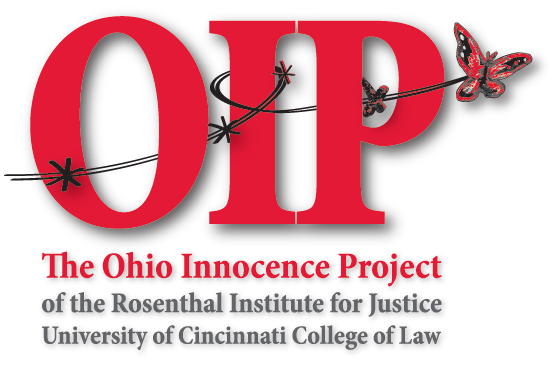
Ohio Innocence Project
OIP at the University of Cincinnati
Founded by John Cranley and current OIP director Mark Godsey in 2003, the Ohio Innocence Project’s work has led to the release of 42 wrongfully convicted Ohioans, including the six featured in Blind Injustice. The OIP is part of the Innocence Network, a coalition of organizations working to overturn wrongful convictions around the world.
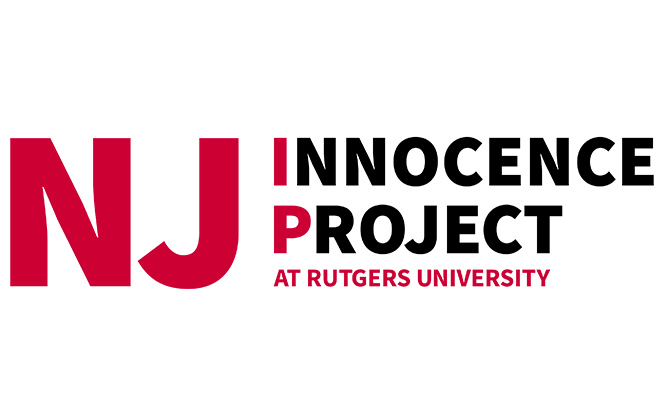
New Jersey Innocence Project
The first New Jersey-based member of the National Innocence Network, NJIP provides legal representation to wrongfully convicted people in their quests to establish their innocence and works to prevent wrongful convictions through system change advocacy. The project is based at Rutgers Law School and draws on the expertise and resources of Rutgers faculty from other disciplines, including criminal justice, forensic science, and social work, among others.
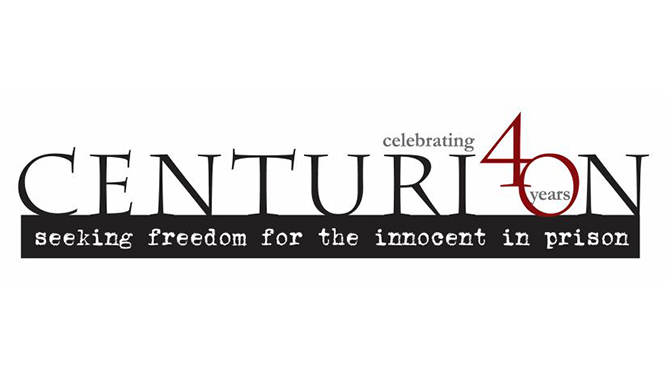
Centurion Ministries
Based in Princeton, New Jersey, Centurion Ministries was the first organization in the world dedicated to the vindication of the wrongly convicted. Since 1983, they have had 70 releases from prison of men and women who were serving life or death sentences for crimes they did not commit.
Section 2: The Facts
Listen to more music from the opera on Spotify.
“We live in an age of scientific precision.
Knowledge beyond all doubt or derision.”
Every state in the U.S. has wrongfully convicted innocent people. Below are facts, graphs, and maps to help illustrate the impact wrongful conviction can have, and the progress made by the wrongful incarceration movement. To learn more, visit The National Registry of Exonerations or the Innocence Project.
Below information courtesy of the Innocence Project. Data based on their work since their founding in 1992.
Average age when wrongly convicted.
Average age when exonerated.
of the exonerees are black.
of the exonerees are white.
are Latinx.
are Native American, Asian-American or other.
involved eyewitness misidentification.
involved misapplied forensic science.
involved false confessions.
involved informants.
Range of costs for DNA testing of evidence for one case.
Below information courtesy of Witness to Innocence, an organization dedicated to death row exonerations. Data from 1976 to the present.
195 people from 28 states have been exonerated from death row.
11.5 years is the average time a death row exoneree spent in prison for a crime they did not commit.
4.1% of people currently on death row are likely to be innocent according to the National Academy of Sciences.
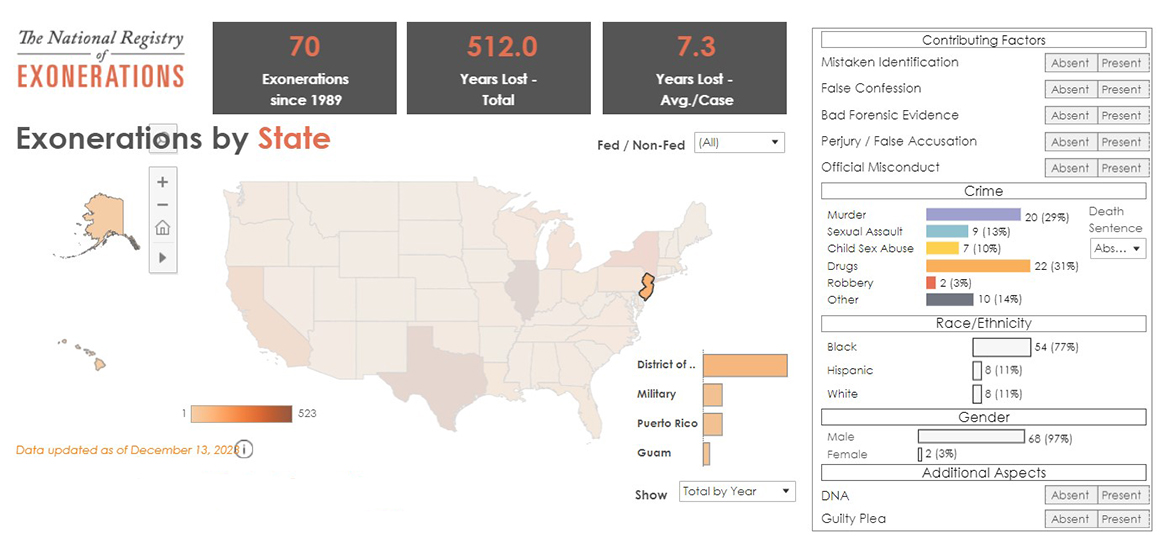
Exonerations in the United States Map (umich.edu)
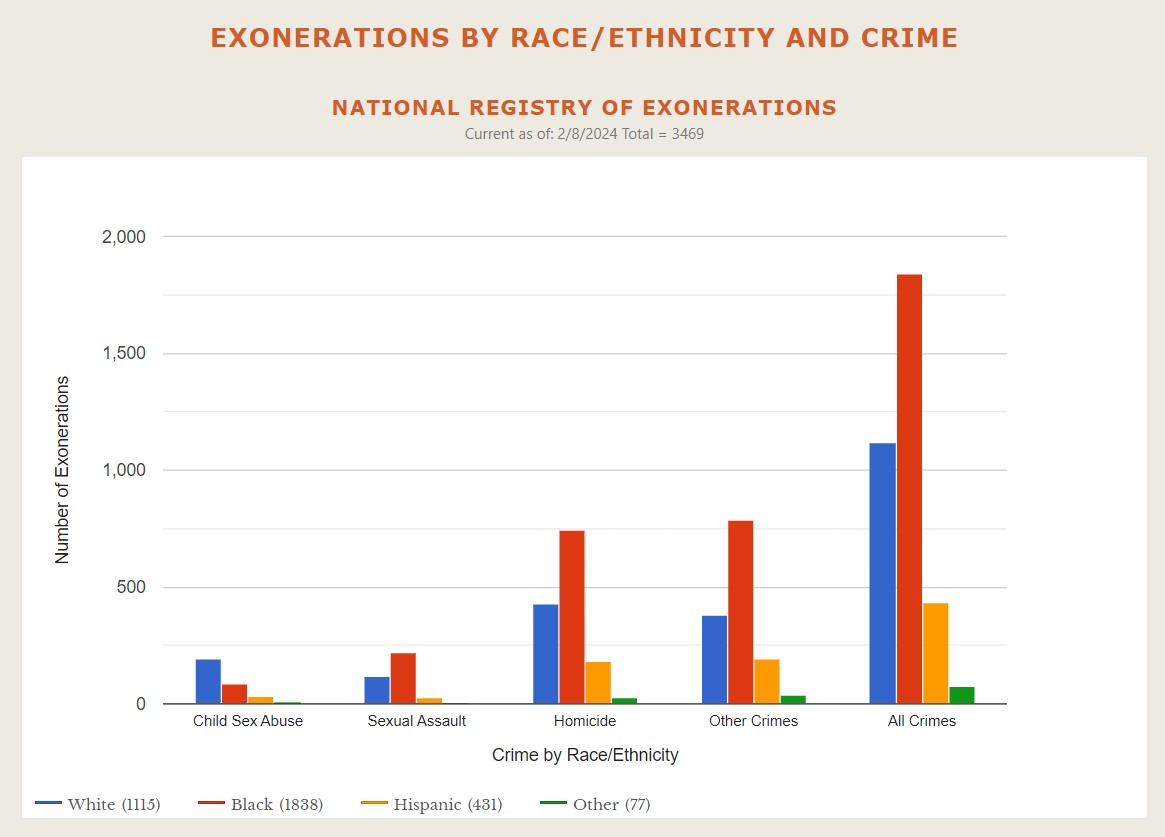
Exonerations Race by Crime (umich.edu)

Exoneration by Year (umich.edu)
Section 3: The Causes
Listen to more music from the opera on YouTube or Spotify.
“You grab the wrong guy,
And you become blind to anything
But the evidence you want to see.”
Many factors can lead to a wrongful conviction. Some are systematic, while others are psychological biases and blind spots that create additional barriers to justice.
Blind Injustice by Mark Godsey explores six biases that can cause wrongful conviction. Learn more and purchase his book here.
Blind Denial – Often, when an individual is arrested or charged with a crime, prosecutors, and police are already certain of their guilt. As a result, they may deny signs of innocence, even seemingly obvious ones.
Blind Ambition – The legal system in the U.S. favors police, prosecutors, and judges who arrest and imprison people frequently, while defenders are given little support. This makes it easier to find people guilty rather than prove their innocence.
Blind Bias – Confirmation bias affects everyone, meaning that we look for evidence in favor of what we already believe. This can affect forensic science and fingerprint identification, leading to finding patterns that aren’t there.
Blind Memory – Memory is highly unreliable, and can be influenced or modified after the fact. Cases involving eyewitness testimony, or even testimony from victims of crimes, can be unreliable.
Blind Intuition – Police, prosecutors, and juries often rely on their ability to determine if an individual is lying, but this can be harder than it seems. Additionally, behaviors under stress (like interrogation) can be unpredictable and misleading.
Blind Tunnel Vision – The desire to “win” and “crack cases” encourages confirmation bias and the assumption of guilt in prosecutor’s offices and police forces.
Section 4: Learn More & Act
Listen to more music from the opera on YouTube or Spotify.
“Smash bricks into dust!
Bust it! Bust it! Bust it!
Bust this goddamned prison down!”
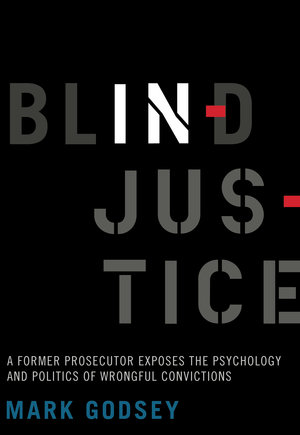
Blind Injustice by Mark Godsey
Prosecutor turned champion for the innocent Mark Godsey takes us inside the frailties of the human mind as they unfold in real-world wrongful convictions. Drawing upon stories from his own career, Godsey shares how innate psychological flaws coupled with a “tough on crime” environment can cause investigations to go awry, leading to the convictions of innocent people.
Blind Injustice Opera Sets Out To Open Eyes About Wrongful Conviction Rates: NPR
“About 40 percent of the Blind Injustice libretto comes directly from interviews with these wrongfully convicted subjects. In those interviews, some exonerees discussed experiences that they rarely shared with anyone.” – by Elizabeth Kramer
Giving a Voice to the Voiceless — Cincinnati Opera
“I’ll never forget how moved the creative team was when they first sat down with the exonerees and started hearing their stories face to face. I already knew that these six exonerees were living embodiments of the heroic protagonists that writers strive to create in works of operatic fiction.” – by Mark Godsey
From prison to center stage | University of Cincinnati (uc.edu)
“Exoneree Smith admits she was skeptical when Godsey first suggested the idea of turning her story into an opera. But after hearing her aria, ‘Nancy’s Song,’ and other Blind Injustice pieces performed at a workshop last fall, she and her fellow exonerees have all become true believers in the overwhelming power of the operatic form.” – from UC Magazine
Wrongful Incarceration 101:
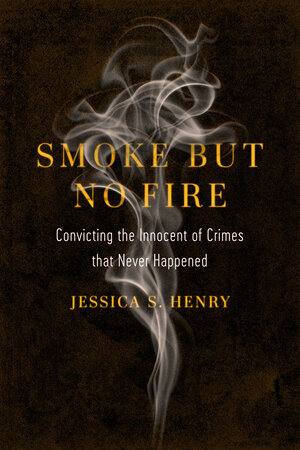
Smoke but No Fire by Jessica S. Henry
A full one-third of all known exonerations stem from no-crime wrongful convictions. Smoke but No Fire tells the heartbreaking stories of innocent people convicted of crimes that simply never happened. With this book, former New York City public defender and Montclair State University professor Jessica S. Henry sheds essential light on a deeply flawed criminal justice system that allows—even encourages—these convictions to regularly occur.
The National Registry of Exonerations – Exoneration Registry (umich.edu)
The Registry provides detailed information about every known exoneration in the United States since 1989—cases in which a person was wrongly convicted of a crime and later cleared of all the charges based on new evidence of innocence.
Educational Resources – University of Cincinnati College of Law | University of Cincinnati
Learn more about the OIP and their resources for combating wrongful incarceration.
Innocence Project’s Wrongful Conviction Reading Guide
An expansive list of “must-read” books, articles, and media from the groundbreaking Innocence Project.
Innocence Research
An academic database for researchers, educators and more looking to participate in the work around wrongful convictions.
How to Take Action:
Donate, volunteer, or get in touch with the organizations below to join the movement and make a change.
Ohio Innocence Project
Welcome to the Ohio Innocence Project at Cincinnati Law, where our goal is simple: we want to free every innocent person in Ohio who has been convicted of a crime they didn’t commit.
Innocence Network
The Innocence Network is a coalition of organizations dedicated to providing pro bono legal and investigative services to individuals seeking to prove innocence of crimes for which they have been convicted, working to redress the causes of wrongful convictions, and supporting the exonerated after they are freed.
Find your local chapter: Network Member Organization Locator and Directory
After Innocence: When wrongful incarceration ends, our work begins.
After Innocence has made free post-release assistance available to more than 800 people who were imprisoned for crimes they did not commit. Help us reach every exoneree in the U.S.
Witness to Innocence | Empowering Death Row Survivors
Witness to Innocence (WTI) is an organization in the United States composed of and led by exonerated death row survivors and their family members. The mission of WTI is to abolish the death penalty and reform the United States justice system by empowering exonerated death row survivors and their loved ones to become effective leaders.

